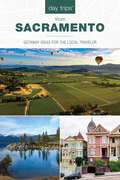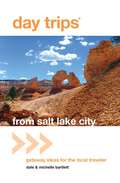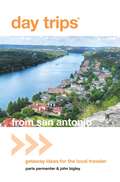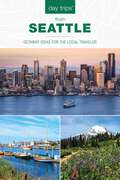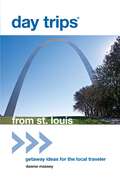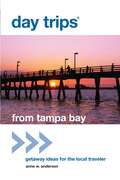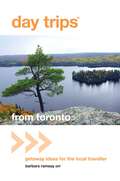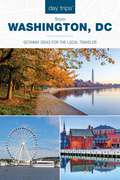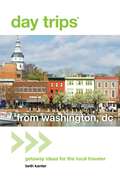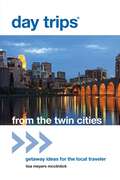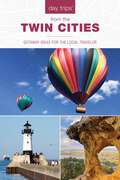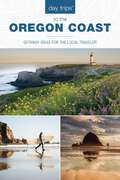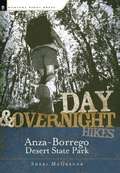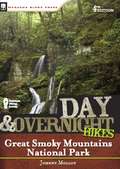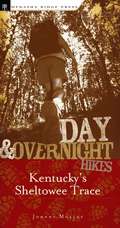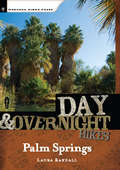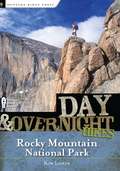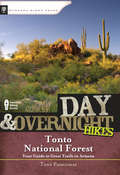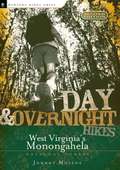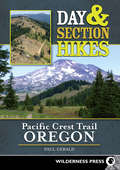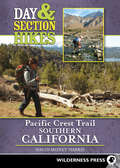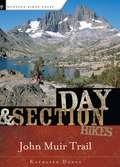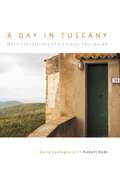- Table View
- List View
Day Trips® from Sacramento: Getaway Ideas for the Local Traveler
by Karen MisuracaNo planning required! Rediscover the simple pleasures of a day trip with Day Trips® from Sacramento. Packed with full trip-planning information for hundreds of exciting things for locals and vacationers to do, see, and discover—all within a two-hour drive of Sacramento— Day Trips® from Sacramento helps make the most of a brief getaway. This up-to-date guide features 15+ customizable getaways that detail where to shop, eat, play, and stay while you&’re traveling. From the sun-soaked vineyards of Sonoma and Napa to the glittery pavements of Los Angeles, and the tranquility of Lake Tahoe, take the guesswork out of planning your excursion with Day Trips® from Sacramento.
Day Trips® from Salt Lake City: Getaway Ideas for the Local Traveler (Day Trips Series)
by Michelle BartlettRediscover the simple pleasures of a day trip with Day Trips from Salt Lake City. This guide is packed with hundreds of exciting things for locals and vacationers to do, see, and discover all within a 2-hour drive.
Day Trips® from San Antonio: Getaway Ideas for the Local Traveler (Day Trips Series)
by John Bigley Paris PermenterRediscover the simple pleasures of a day trip with Day Trips from San Antonio. This guide is packed with hundreds of exciting things for locals and vacationers to do, see, and discover within a two-hour drive of the San Antonio metro area.
Day Trips® from Seattle: Getaway Ideas For The Local Traveler (Day Trips Series)
by Chloe ErnstNo Planning Required! Rediscover the simple pleasures of a day trip with Day Trips from Seattle. Packed with full trip-planning information for hundreds of exciting things for kids, outdoor adventurers, and history lovers to do—all within a two-hour drive of the Seattle metro area. Day Trips from Seattle helps locals and vacationers make the most of a brief getaway.Do something scenic: Hike to the hot springs in Olympic National Park, follow the Oregon Trail, or visit stunning Mount St. Helens.Do something kid-approved: Visit Point Defiance Park or the Children&’s Museum in Tacoma; or explore Science World or the Aquarium in Vancouver, British Columbia. Do something festive: Partake in Poulsbo&’s Viking Fest in May, Puyallup&’s late-summer fair, the fall grape crush at Woodinville&’s wineries, or a winter cowboy gathering in Ellensburg.
Day Trips® from St. Louis: Getaway Ideas for the Local Traveler (Day Trips Series)
by Dawne MasseyGetaway Ideas for the Local Traveler Rediscover the simple pleasures of a day trip with this fun and friendly guide. For local travelers seeking new adventures in their own backyards as well as for vacationers looking to experience all the excitement the area has to offer, each Day Trips® guide offers hundreds of activities to do, sights to see, and secrets to discover within a two- to three-hour drive and a route map for each itinerary. Complete with full trip-planning information including where to go, what to see, where to eat, where to shop as well as where to stay options for those who want to extend their Day Trip into a weekend. In Spring 2012 we are proud to be publishing six all new guides—The Carolinas, New Jersey, Philadelphia, St. Louis, Tampa and St. Petersburg, and the Twin Cities—as well as an updated edition of Day Trips from Kansas City.
Day Trips® from Tampa Bay: Getaway Ideas for the Local Traveler
by Anne AndersonGetaway Ideas for the Local TravelerRediscover the simple pleasures of a day trip with this fun and friendly guide. For local travelers seeking new adventures in their own backyards as well as for vacationers looking to experience all the excitement the area has to offer, each Day Trips® guide offers hundreds of activities to do, sights to see, and secrets to discover within a two- to three-hour drive and a route map for each itinerary. Complete with full trip-planning information including where to go, what to see, where to eat, where to shop as well as where to stay options for those who want to extend their Day Trip into a weekend.
Day Trips® from Tampa Bay: Getaway Ideas for the Local Traveler (Day Trips Series)
by Anne AndersonGetaway Ideas for the Local Traveler Rediscover the simple pleasures of a day trip with this fun and friendly guide. For local travelers seeking new adventures in their own backyards as well as for vacationers looking to experience all the excitement the area has to offer, each Day Trips® guide offers hundreds of activities to do, sights to see, and secrets to discover within a two- to three-hour drive and a route map for each itinerary. Complete with full trip-planning information including where to go, what to see, where to eat, where to shop as well as where to stay options for those who want to extend their Day Trip into a weekend. In Spring 2012 we are proud to be publishing six all new guides—The Carolinas, New Jersey, Philadelphia, St. Louis, Tampa and St. Petersburg, and the Twin Cities—as well as an updated edition of Day Trips from Kansas City.
Day Trips® from Toronto: Getaway Ideas for the Local Traveller (Day Trips Series)
by Barbara OrrRediscover the simple pleasures of a day trip with Day Trips from Toronto. This guide is packed with hundreds of exciting things for locals and vacationers to do, see, and discover most within a two- to three-hour drive of the Toronto metro area.
Day Trips® from Washington, DC: Getaway Ideas for the Local Traveler
by Kaeli ConfortiPacked with full trip-planning information for hundreds of exciting things for locals and vacationers to do, see, and discover—all within a two-hour drive of the DC metro area— Day Trips® from Washington, DC helps make the most of a brief getaway. This up-to-date guide features 25+ customizable getaways that detail where to shop, eat, play, and stay while you&’re traveling. From the historic gardens in Wheaton to the sugarloaf mountains in Frederick, to the bustling shopping district in Baltimore, and to the ocean-to-table dining spots in Annapolis, take the guesswork out of planning your excursion with Day Trips® from Washington, DC.
Day Trips® from Washington, DC: Getaway Ideas for the Local Traveler (Day Trips Series)
by Beth KanterRediscover the simple pleasures of a day trip with Day Trips from Washington, D.C. This guide is packed with hundreds of exciting things for locals and vacationers to do, see, and discover all within a 2-hour drive. With full trip-planning information, Da
Day Trips® from the Twin Cities: Getaway Ideas for the Local Traveler (Day Trips Series)
by Lisa Meyers McClintickNo planning required!Need a day away to relax, refresh, renew? Just get in your car and go! This first edition of Day Trips from the Twin Cities is your guide to hundreds of exciting things to do, see, and discover in your own backyard. With full trip-planning information and tips on where to eat, shop, and stop along the way, you can make the most of your time off and rediscover the simple pleasures of a day trip. Explore places you never knew existed, many free of charge, and most within a two-hour drive of Minneapolis and St. Paul, Minnesota.Head north any time of the year to Brainerd, where its bounty of lakes offers waterskiing and wakeboarding in the summer, and snowmobiling and ice fishing in the winter.Follow Wisconsin&’s Great River Road and soak up the beautiful scenery and historic villages tucked along the landscape.Get a taste of Germany in New Ulm, a city that wears its heritage proudly through its ornate buildings, historic brewery, and fun festivals.
Day Trips® from the Twin Cities: Getaway Ideas for the Local Traveler (Day Trips Series)
by Lisa Meyers McClintickRediscover the simple pleasures of a day trip with Day Trips from the Twin Cities. This guide is packed with hundreds of exciting things for locals and vacationers to do, see, and discover within a two-hour drive of the Minneapolis/St. Paul metro area. With full trip-planning information, Day Trips from the Twin Cities helps make the most of a brief getaway.
Day Trips® to the Oregon Coast: Getaway Ideas for the Local Traveler (Day Trips Series)
by Kim Cooper FindlingCalling all Oregon residents and visitors who want to hit the beach armed with an expert-driven itinerary and all the know-how to make the most of a family day trip. Day Trips to the Oregon Coast presents narrative itineraries detailing the perfect travel day in each of 21 Oregon Coast destinations, traveling north to south. Learn where to go, what to see, and what to do as a family in each region of the Oregon Coast. Insider tips, narrative anecdotes and a detailed step-by-step itinerary guide you on your next adventure.
Day and Overnight Hikes: Anza-Borrego Desert State Park
by Sheri McgregorAnza Borrego Desert State Park is the largest desert park in the United States, drawing approximately 650,000 visitors per year. Combining detailed narrative with GPS-based trail maps, Day and Overnight Hikes: Anza-Borrego Desert State Park breaks down the best of the best hikes, both day and overnight. Whether it's the best view over Culp Valley, a walk through Hellhole Canyon, or a flat walk through hills and dales near the Salton Sea, Day and Overnight Hikes is the definitive go-to guide to enjoy the largest desert park in the United States, just an hour's drive from San Diego.
Day and Overnight Hikes: Great Smoky Mountains National Park
by Johnny MolloyWith 500,000 acres of land, it's hard to know where to start in this majestic national park. This fully updated edition of the popular guide eases the process for novice and veteran hikers alike. Comprehensive and compact, the book profiles 31 day-hikes, both one-way and loop, and 10 overnight hikes. Each profile includes a detailed description, maps and trailhead directions, and a trail summary that rates the difficulty, solitude, and scenery of each hike while outlining significant sites along the way. Destinations include the Little Greenbrier Trail to Walker Sisters Place, one of the last working pioneer homesteads in the Smokies, and the remote and stunning Hyatt Ridge Loop. Easily carried in a backpack, this book has hikes suitable for anyone who prefers vacationing on the trail rather than behind another car.
Day and Overnight Hikes: Kentucky's Sheltowee Trace
by Johnny MolloyThis book details the 282 miles of Kentucky's master path, the Sheltowee Trace, from the trail's southern terminus in Tennessee's Pickett State Park, north through the Big South Fork National River and Recreation Area and on through the length of the Daniel Boone National Forest nearly to the state of Ohio.
Day and Overnight Hikes: Palm Springs
by Laura RandallPalm Springs has long been known by Los Angeles residents for its beautiful hiking trails. With the Joshua Tree National Monument to the east, the San Bernardino National Forest north and south, and the Pacific Crest Trail not far away, this area is rife with wonderful outdoor opportunities. This book collects each of them and offers detailed ratings and maps for use out on the trail, providing an invaluable resource for hikers of all levels.
Day and Overnight Hikes: Rocky Mountain National Park
by Kim LipkerRocky Mountain National Park is the living showcase of the grandeur of the Rockies, with elevations ranging from 8,000 feet in the valleys to 14,259 feet at the top of Longs Peak. Choosing the best day and overnight hikes from the 359 miles of hiking trails and 200 backcountry sites is a major task. First-time, novice, and seasoned hikers hit the trail faster with this practical illustrated guide. Whether looking to watch the elk rut in autumn, the summer blooms on the hillside, the thundering falls in spring, or the white-blanketed calm of the forest in winter, readers can find everything they need here. From Grand Lake in the west to Estes Park in the east, this guide covers the park with original GPS-based trail maps, detailed trail descriptions, overnight camping recommendations, trail guides suitable for different experience levels, and more.
Day and Overnight Hikes: Tonto National Forest
by Tony PadegimasCentral Arizona's most popular forest area houses six separate ecosystems, and much of it can only be seen on foot. Hikers have long known about the natural wonders that exist here, and this guide corrals all of the best hikes - no small task, since there are over 900 miles of trails in the park. Offering detailed descriptions of each hike, along with practical, need-to-know logistical information, this guide demystifies a truly enormous and beautiful stretch of wilderness.
Day and Overnight Hikes: West Virginia's Monongahela National Forest
by Johnny MolloyThe heart and soul of wild, wonderful West Virginia, the mighty Monongahela National Forest is within a day's drive of one-third of the population of the United States. The best way to see and experience the stately forests and pristine waterfalls is by foot. Day and Overnight Hikes: West Virginia's Monongahela National Forest will guide visitors the entire way while exploring this national treasure.
Day and Section Hikes Pacific Crest Trail: Oregon
by Paul GeraldThe Pacific Crest Trail was designated as one of the first National Scenic Trails way back in 1968. As it traverses the "high road" from Mexico to Canada, incredible views are not only commonplace but also uniquely diverse, because the trail connects six of North America's seven eco-zones. The PCT's familiar, well-worn path is a special place for hikers from all walks of life on walks of all lengths and for all reasons.Instead of guiding you through the arduous task of hiking the entire PCT, the goal of this book is to help you plan trips that incorporate hiking on the PCT in Oregon, whether you have just an afternoon to spare or you want to escape for the entire weekend.Carefully edited maps and elevation graphs generated with GPS data collected by the author on the trail will help make your trip a success.This cargo-pocket guide offers author-tested advice to help you make the most of your time away from civilization, however long (or short) that stretch may be.
Day and Section Hikes Pacific Crest Trail: Southern California
by David Money HarrisThe Pacific Crest Trail was designated as one of the first National Scenic Trails way back in 1968. As it traverses the "high road" from Mexico to Canada, incredible views are not only commonplace but also uniquely diverse, because the trail connects six of North America's seven eco-zones. The PCT's familiar, well-worn path is a special place for hikers from all walks of life on walks of all lengths and for all reasons.Instead of guiding you through the arduous task of hiking the entire PCT, the goal of this book is to help you plan trips that incorporate hiking on the PCT in Southern California, whether you have just an afternoon to spare or you want to escape for the entire weekend.Carefully edited maps and elevation graphs generated with GPS data collected by the author on the trail will help make your trip a success.This cargo-pocket guide offers author-tested advice to help you make the most of your time away from civilization, however long (or short) that stretch may be.
Day and Section Hikes: John Muir Trail
by Kathleen DodgeThe John Muir Trail runs a spectacular 211 miles from Yosemite Valley to the foot of Mount Whitney, crossing through Kings Canyon and Sequoia national parks, the Inyo National Forest, and the Devils Postpile National Monument. This guide has descriptions for six day hikes, five overnight hikes, and the entire trail in six sections, and includes transit and lodging information, altitude profiles, a GPS-based trail map, and ratings for scenery, trail condition, difficulty, accessibility for children, and solitude.
Day in Tuscany: More Confessions of a Chianti Tour Guide
by Robert Rodi Dario CastagnoThis second book from Dario Castagno is a delightfully honest mix of memoirs from life in the hills of Tuscany's legendary Chianti region. Set on the day the author arrived home after a three-month tour of the United States promoting his first book, A Day in Tuscany compels readers to experience this enchanted corner of Italy through the heart and mind of a true Tuscan. As Castagno sees his beloved hills with fresh eyes and reacquaints himself with the rhythms of home, a flood of recollections of its people and places come to him. Through his engaging narrative, we are transported as well.The sights he sees and people he meets as he takes a one-mile walk through his village during the course of this noteworthy day trigger memories of his childhood and adolescence in Tuscany during the seventies, his experiences as a tour guide in Chianti, and some of the more remarkable people he has known. In addition to stories from his own past, included are oral histories from several village elders.History and the present mingle in this part of the world, and these stories bring both alive. Sometimes funny, often poignant, A Day in Tuscany weaves a magical spell and offers a candid insider's look at the people and culture of a fascinating land.
